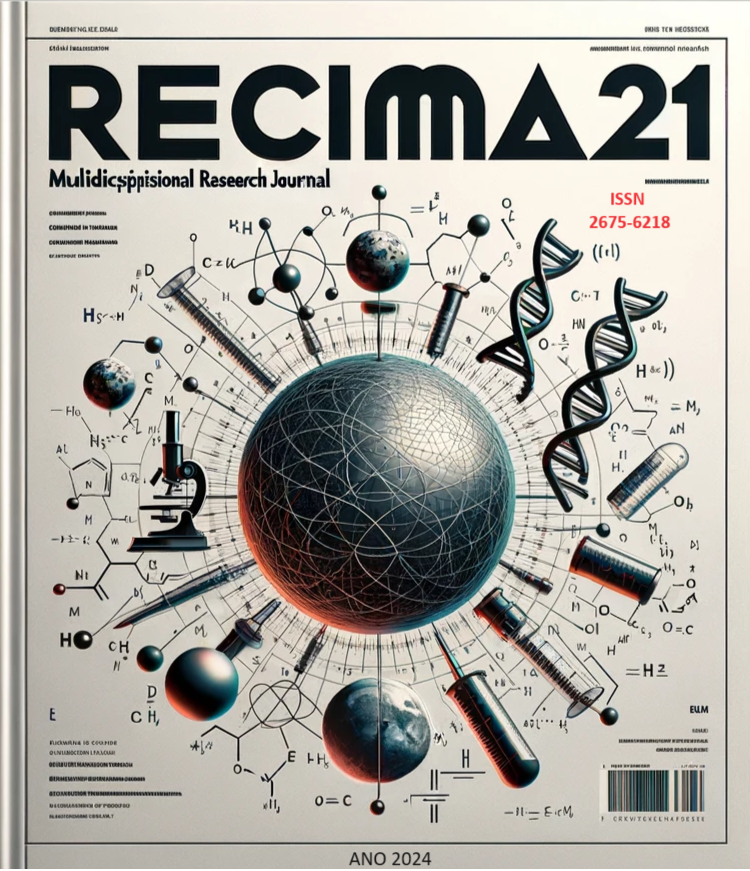EFEITO BIOLÓGICO DO SOM FRENTE AO DESENVOLVIMENTO LARVAL DE AEDES AEGYPTI
DOI:
https://doi.org/10.47820/recima21.v5i5.5129Palavras-chave:
Controle Vetorial. Desenvolvimento Larval. Ondas Sonoras.Resumo
A percepção ou sensação de som é gerada a partir de vibrações das partículas do ar no órgão responsável por detectar essas variações, o tímpano no caso dos humanos e os órgãos sensoriais no caso dos insetos. Muito se fala em meios de controles vetoriais, para tanto, usualmente são utilizados produtos químicos, microrganismos e até ondas sonoras como repelentes eletrônicos. Com o intuito de compreender como se dá o desenvolvimento larval de Aedes aegypti, submetido a frequências sonoras especificas, foram realizados experimentos em triplicata com aparelhos sonoros emitindo ondas nas frequências de 14, 40 e 80 kHz. Esse experimento foi dividido em dois momentos, um primeiro sem intermitência e um segundo com um timer controlando os aparelhos emissores de som, aplicando-se em bandejas contendo larvas de A. aegypti que foram eclodidas no laboratório da Unidade Acadêmica de Serra Talhada. Através do experimento foi possível perceber, utilizando-se o programa R-studio com o teste T-student, que os resultados não foram significativos com relação ao tempo de desenvolvimento, mas foi possível observar que houve uma aceleração no larval das que estavam com o timer controlando os períodos de acionamento dos aparelhos sonoros.
Downloads
Referências
BRITO, R. R.; SOUSA, N. P. R.; LIMA, C. D.; SOUZA, D. P. M. Aspectos Epidemiológicos e as Adaptações do Aedes aegypti: Considerações Sobre Arboviroses. JNT-Business and Technology Jornal, Tocantins, v. 1, n. 19, p. 205-213, 2020.
BROWN, J. E.; EVANS, B. R.; ZHENG, W.; OBAS, V.; BARRERA-MARTINEZ, L.; EGIZI, A.; ZHAO, H.; CACCONE, A.; POWELL, J. R. Human impacts have shaped historical and recent evolution in Aedesaegypti, the dengue and yellow fever mosquito. NIH Public Access, v. 68, n. 2, p. 514–525, 2014. DOI: https://doi.org/10.1111/evo.12281
CABRINI, I. Avaliação de repelentes eletrônicos e estudos quanto a eficiência de transposição de telas, utilizando-se Aedes aegypti (Linnaeus, 1762) E Aedes albopictus (Skuse, 1854) (DIPTERA: CULICIDAE). 2005. Dissertação (Mestre em Parasitologia) – Universidade Estadual de Campinas, Campinas, 2005.
COSTA, I. M.; CALADO, D. C. Incidência dos casos de dengue (2007-2013) e distribuição sazonal de culicídeos (2012-2013) em Barreiras, Bahia. Epidemiologia e Serviços de Saúde, v. 25, n. 4, p. 735–744, 2016. DOI: https://doi.org/10.5123/S1679-49742016000400007
FARIAS, A. A. Avaliação de repelência eletrônica para formiga MonomoriumfloricolaJerdon, 1851 (Hymenoptera, Formicidae) e baratas Periplaneta americana Linneu, 1758 (Dictyoptera, Blatidae) E Blattellagermanica (L.) (Dictyoptera, Blattellidae). 2008. Dissertação (Especialista em Entomologia Urbana: Teoria e Prática) - Universidade Estadual Paulista, Rio Claro, SP, 2008.
GIOVANELLA, R. Uso de frequências sonoras no controle de cupins de madeira seca Cryptotermes sp. (Isoptera: Kalotermitidae). 2009. Dissertação (Mestrado em Engenharia Florestal) - Universidade Federal do Paraná, Curitiba, 2009.
GIOVANELLA, R.; ROCHA, M. P.; BERLEZE, S. L. M. Campo Eletromagnético e o Fenômeno de Taxia em Cupins de Madeira Seca (CryptotermesBrevis). Floresta e Ambiente, v. 21, n. 4, p. 551-560, 2014. DOI: https://doi.org/10.1590/2179-8087.066513
MACCAGNAN, D. H. Armadilha sonora. Revista Pesquisa Fapesp, p 68-69, 2008. Acessado em: novembro de 2019. Disponível em: https://revistapesquisa.fapesp.br/wp-content/uploads/2008/10/lp_brasil152.pdf.
MOORE, M.; SYLLA, M.; GOSS, L.; BURUGU, M. W.; SANG, R.; KAMAU, L. W.; KENYA, E. U.; BOSIO, C.; MUNOZ, M. L.; SHARAKOYA, M.; BLACK, W. C. Dual African Origins of Global Aedes aegypti. l. Populations Revealed by Mitochondrial DNA. PLoS Neglected Tropical Diseases, v. 7, n. 4, 2013. DOI: https://doi.org/10.1371/journal.pntd.0002175
OLIVEIRA, N. C.; SOUZA, D. T. F.; MARTINS, M.; SOUZA, E. A.; MEDEIROS, M. O. Din mica populacional de Aedes (Stegomyia) aegypti (Linnaeus, 1762) (DIPTERA: CULICIDAE) no Campus Universitário De Rondonópolis, Biodiversidade, v. 16, n. 2, 2017.
PICINATO, M. A. C.; GRISOLIO, A. P. R.; CASELANI, K.; NUNES, J. O. R.; CARVALHO, A. A. B.; FERRAUDO, A. S. Dengue: uma visão sobre o vetor urbano Aedes aegypti e a difícil interface do seu controle. Veterinária em Foco, v. 13, n. 1, p. 11–25, 2015.
SEARS, F.; ZEMANSKY, M. W.; YOUNG, H. D. Física- Mecânica dos Fluidos, Calor, Movimento Ondulatório. Rio de Janeiro: LTC, 1989.
SILVA, Geisa Santos. Aedes aegypti e Aedes albopictus (skuse) (Diptera: Culicidae) no município de Codó, Maranhão. 2016. 36f. Trabalho de Conclusão de Curso (Graduação) - UFMA, Maranhão, 2016.
YÁÑEZ, P.; MAMANI, E.; VALLE, J.; GARCIA, M. P.; LEON, W.; VILLASECA, P.; TORRES, D.; CABEZAS, C. Genetic variability of Aedes aegypti determined by mitochondrial gene ND4 analysis in eleven endemic areas for dengue in Peru. Revista Peruana De Medicina Experimental Salud Pública, v. 30, n. 2, p. 246–250, 2013. DOI: https://doi.org/10.17843/rpmesp.2013.302.199
ZARA, A. L. S. A.; SANTOS, S. M.; FERNANDES-OLIVEIRA, E. S.; CARVALHO, R. G.; COELHO, G. E. Estratégias de controle do Aedes aegypti: uma revisão. Epidemiol. Serv. Saúde [online]. v. 25, n. 2, p. 391-404, 2016. DOI: https://doi.org/10.5123/S1679-49742016000200017
Downloads
Publicado
Licença
Direitos de Autor (c) 2024 RECIMA21 - Revista Científica Multidisciplinar - ISSN 2675-6218

Este trabalho encontra-se publicado com a Licença Internacional Creative Commons Atribuição 4.0.
Os direitos autorais dos artigos/resenhas/TCCs publicados pertecem à revista RECIMA21, e seguem o padrão Creative Commons (CC BY 4.0), permitindo a cópia ou reprodução, desde que cite a fonte e respeite os direitos dos autores e contenham menção aos mesmos nos créditos. Toda e qualquer obra publicada na revista, seu conteúdo é de responsabilidade dos autores, cabendo a RECIMA21 apenas ser o veículo de divulgação, seguindo os padrões nacionais e internacionais de publicação.













